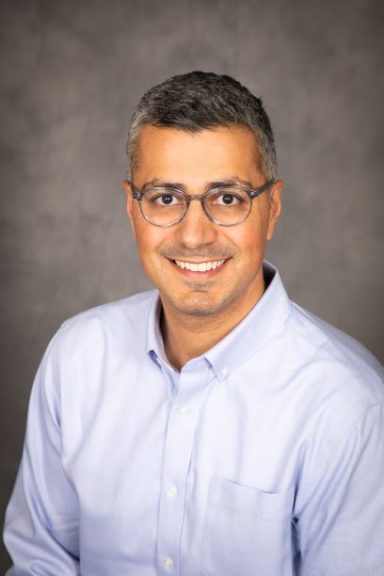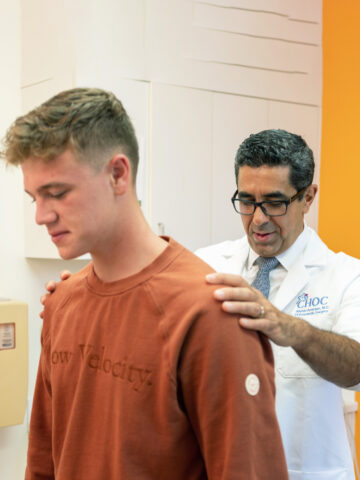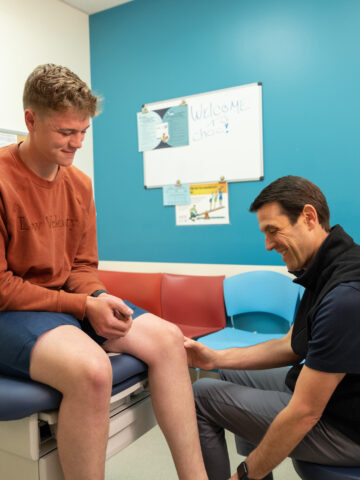The growing and pliable bones of young people can be beset by a range of problems, from simple fractures to dangerous cancer. They can even be impacted by the recent COVID-19 pandemic, noted CHOC orthopaedic surgeon Dr. Amirhossein Misaghi during a recent talk for CHOC’s Grand Rounds titled, “Buckle Fractures, Osteosarcoma, and Some Things In Between.”

An expert in pediatric orthopaedics, Dr. Misaghi treats a variety of orthopaedic conditions. He also has a focus on orthopaedic oncology and is part of the Hyundai Cancer Institute at CHOC’s Bone and Soft Tissue Sarcoma Treatment Program.
With developing bodies and active lives, children are obvious candidates for skeletal problems, according to Dr. Misaghi. But they are also able to overcome many of the problems they encounter with minimal intervention.
“[In kids], there are more resilient bones,” he says. “They can take more stress before they break, the periosteum/lining of the bone is thicker. Also, kids can ‘remodel’ and their crooked bones can grow straight as they heal.”
Managing a patient’s expectations is an important part of treatment. Adult providers may initially tell some patients that they need surgery when they may not. Or sometimes, a patient might expect a certain treatment because they are comparing their condition to someone else in a similar but subtly different situation. He called this the “neighbor problem.”
Younger children might be able to heal an injury with a cast whereas an adult would need surgery.
“There are nuances,” he says. “So, it’s not always the same. Even though patients and parents might think they’re similar injuries.” The injuries and treatments can have subtle differences.
Torus fractures, ankle fractures and other traumatic injuries
Dr. Misaghi noted that doctors saw fewer incidents of fractures and breaks during the pandemic because kids were staying inside more, although this has now changed. Some clinics saw the number of such patients drop in half.
“We were seeing fewer fractures, but they were still coming in,” Dr. Misaghi says. “More of the fractures were happening at home with sports being canceled, and physical education (P.E.) and school not happening.”
Showing X-rays of various injuries, Dr. Misaghi highlighted various types of bone injuries and how to treat them. He focused on parts of the body that are prone to such injuries, including wrists, shoulders, knees and hips, each requiring varying degrees of care.
Torus, or buckle, fractures represent about half the wrist fractures that are treated in children. They typically occur from a fall on an outstretched hand, causing the bone to buckle. They usually take about a month to heal with a brace or cast.
“I describe to the parents that if I could just wrap them in bubble wrap, put them on a shelf for a little while and take them off, they’ll be healed,” Dr. Misaghi says. “The fracture doesn’t need to be held in place It just needs some protection against another fall.”
An injury that could require more complicated treatment is a scaphoid fracture, which impacts bones near the wrist. These can be difficult to heal such a break can take several months to heal in a cast. And Dr. Misaghi discussed that scaphoid injuries are better referred to be cared for by an orthopaedist.
“You should have a high index of suspicion if the X-rays look normal and they have tenderness,” he says. “You’ll still need to refer the patient for a follow up X-ray a few weeks after injury.”
For clavicle fractures, which often occur when a patient falls on a shoulder, Dr. Misaghi says that the best treatment in children and adolescents is often a simple sling. Surgery is rarely needed for these injuries.
“My general advice to families and young kids with clavicle fractures is if the two ends of the bone are in the same room, it’s going to heal and it doesn’t need surgery,” he says.
Ankle fractures can be identified with a series of X-rays and can be treated with a period of immobility by employing a boot, but more serious injuries may require a cast or even surgery.
Benign tumors: Aneurysmal bone cysts, non-ossifying fibroma, osteochondroma
Dr. Misaghi then turned his attention to benign tumors where he has a special interest. Unicameral bone cysts, or simple cysts, can be latent or growing. A child may not even know that such a cyst exists until they injure the area. When discovered they should be watched over but should not cause alarm.
Aneurysmal bone cysts (ABC) are also benign but can be larger, more aggressive and cause some swelling and pain. Surgery may be necessary to treat ABC’s.
Another common benign tumor that he discussed is called an osteochondroma. Typically, they are masses found around the knee joint; if painful, they can be removed by surgery.
Malignant tumors: Primary bone sarcomas
Finally, Dr. Misaghi discussed Malignant bone tumors where he has special training and a second fellowship. Typically, when people think about orthopaedic issues, they tend to think about broken bones and sports injuries, not cancer.
Although not common, malignant cancers of the musculoskeletal system can occur and can require chemotherapy and major surgery. Doctors treat more than a million ankle fractures and joint replacements a year, but fewer than a thousand osteosarcomas, which are bone-producing cancers.
“Thankfully, primary bone sarcomas are pretty rare in the U.S.,” Dr. Misaghi says. “However, they are most common in the pediatric population.”
CHOC oncologists and surgeons are part of the multidisciplinary, advanced team that manages these special pediatric conditions. With modern treatments including chemo and surgery survival with bone sarcomas is now common and much improved over the pre-chemotherapy days.
View Dr. Misaghi’s full lecture, “Buckle Fractures, Osteosarcoma, and some things in between,” here.
Learn more about CHOC’s Orthopaedic and Sports Medicine Services
Our team of board-certified specialists and orthopaedics-trained staff provide a full spectrum of care for disorders of the bones, joints, ligaments, tendons and muscles.




